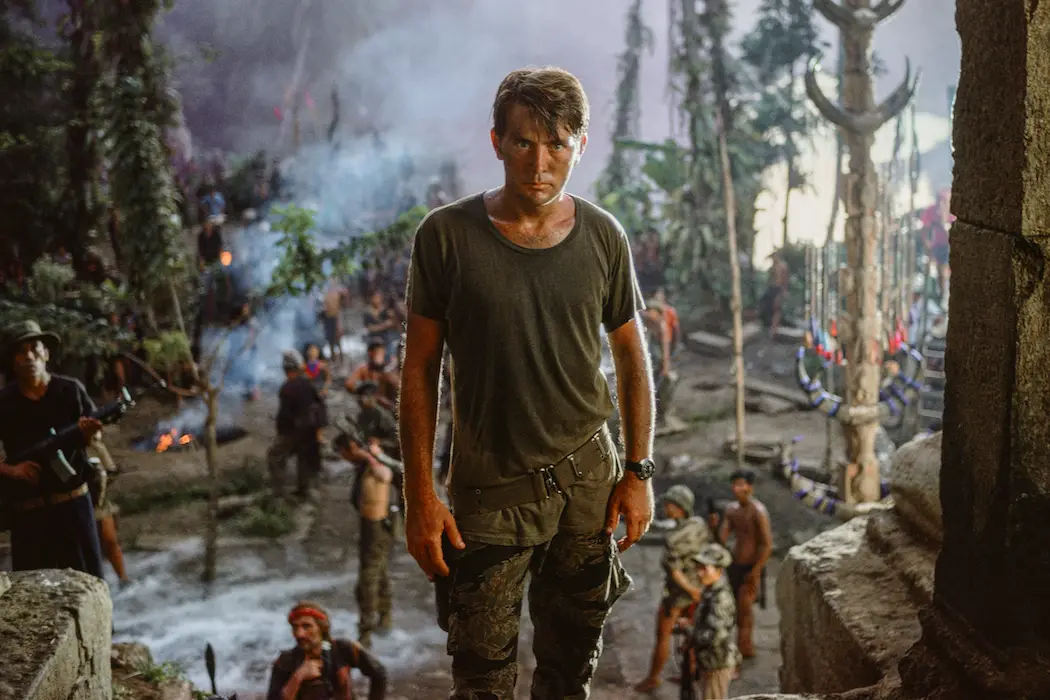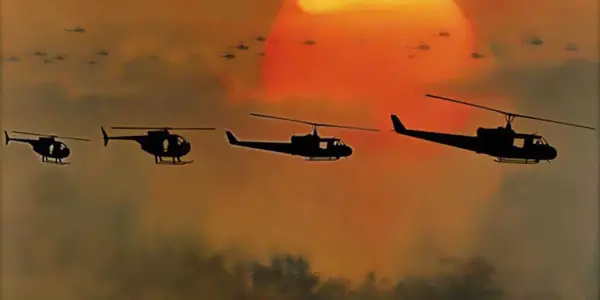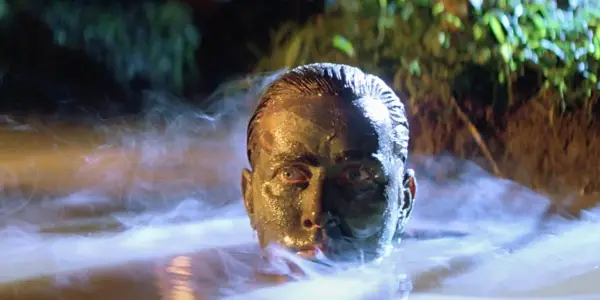“THE HORROR!”: APOCALYPSE NOW AND ITS JOURNEY TO THE END

Lorna Codrai is a freelance journalist based in the UK…
Apocalypse Now is as renowned for its disastrous three-year production as it is for its stark, realistic portrayal of the Vietnam War. Never straying far from any critic or fan’s top ten list, Francis Ford Coppola’s 1979 war epic has achieved almost cult-like status, and no war film has captured the depravity of war the same way since.
The initial six-week shoot in the Philippines turned into sixteen months, with the entire production taking three years to complete. Harvey Keitel, originally portraying Willard, was fired after a month and replaced by Martin Sheen; the cast and crew were surviving on a deadly c*cktail of drugs and booze, and the heat and stress from production did them no favours. Coppola then suffered a breakdown and a seizure, and a typhoon destroyed sets and equipment.

The film’s biggest money draw, Marlon Brando, turned up on-set overweight and unprepared and, later on in production, Sheen suffered a near-fatal heart attack, delaying filming for several weeks. Coppola later stated: “The film was made the way the war was fought. There were too many of us, too much money, too much equipment, and, little by little, we went insane.” It’s not hard to see why the film spawned the 1991 documentary, Hearts of Darkness: A Filmmaker’s Apocalypse (co-directed and narrated by Coppola‘s wife, Eleanor Coppola), chronicling the hellish process.
“I WANTED A MISSION, AND FOR MY SINS THEY GAVE ME ONE.”
Loosely based on Joseph Conrad’s novella Heart of Darkness (1899), Colonel Walter E. Kurtz (Brando) has gone insane and taken control of the indigenous Montagnard people deep in the Cambodian jungle. The burnt-out Captain Benjamin L. Willard (Sheen) is ordered by the military to take a dangerous journey upriver to terminate Kurtz with extreme prejudice.
Opening to the haunting sound of a helicopter’s blade and The Doors’ “The End”, Apocalypse Now promptly informs us that this is a film like no other. Exploding napalm intercuts with our protagonist’s(?) weary face, and the proceeding seven-minute montage of a haunted Willard inside a trashed hotel room foreshadows the nightmare he is about to endure. The journey itself is primarily an action-adventure; however, it’s only as we follow Willard and his crew that we see their trip upriver is really an allegory for the insanity of war and the darkest parts of oneself.

Willard’s crew, comprising of the Chief, surfer dude Lance, New Orleans “saucier” Chef, and c*cky teenager Mr. Clean (Albert Hall, Sam Bottoms, Frederic Forrest, and Laurence Fishburne, respectively), rendezvous with an Oscar-nominated Robert Duvall as Colonel Kilgore. With less than twenty minutes of screen-time, Kilgore leaves quite an impression, famously uttering: “I love the smell of napalm in the morning.” Caring, oblivious to gunfire, and completely nuts; Kilgore just wants to surf and Willard isn’t having any of it. Ensuing is an incredible and haunting spectacle—stunningly shot by Italian cinematographer Vittorio Storaro, who won an Academy Award for his work—of rainbow-tinged smoke, fire, and smouldering chaos after Kilgore drops napalm on a Vietnamese village.
It’s a haunting yet exhilarating sight to behold and Willard, sensibly, gets his crew the hell out of there; the first, but certainly not the last of nightmarish encounters for him and his men. Playboy bunnies, a family massacre, a tiger, and, lastly, Kurtz’ hideaway await the men. It isn’t until the last thirty minutes, when Brando finally emerges from the shadows, that the tense uncertainty really starts to hit home and the possibility of redemption dies.
“I WAS GOING TO THE WORST PLACE IN THE WORLD AND I DIDN’T EVEN KNOW IT YET.”
The big question that remains, however, is whether Willard is a protagonist or antagonist. He’s the fractured emotional centre of the piece, but he’s a soldier sent to kill one of his own. The moral lines are blurred and dark truths are sure to be revealed. Willard, himself, is detached from those around him and relaxed at the prospect of murder, hinting at his unease back home and that his natural state is in combat. Sheen shines in a subtly haunting performance, often overshadowed by his fellow castmates, but Willard is the one who remains seared into your memory.
New viewers will be surprised by Brando’s bloated cameo and the nearly two-hour wait to see the pursued. However, Coppola does his best to utilise his best qualities, namely his mumbling. No drawling monologues have ever appeared quite so unnerving than the ones delivered by Kurtz just hours before his demise. One of the film’s greatest scenes comes with the butchering of Kurtz, which is brutally interwoven with the sacrificial slaughter of an ox by the Montagnard people. It is an ending already implied in the beginning, but its eventual unfolding reveals the full force of the film’s brutality.
“THIS IS THE WAY THE WORLD ENDS! NOT WITH A BANG, BUT WITH A WHIMPER.”
Forty-one years since its release, Apocalypse Now remains a towering achievement and a particular standout within Coppola’s ambitious filmography. The 1970s were his decade, which included the first two Godfather installments, The Conversation, and the screenplays for Patton and the 1974 version of The Great Gatsby.
The 1970s were a tumultuous decade, which—along with the final years of the Vietnam War—saw the Watergate scandal, Richard Nixon’s resignation, the rise in crime and terrorism, and the publication of the Pentagon Papers. The country was still healing from the assassinations of John F. Kennedy, Robert F. Kennedy, and Martin Luther King Jr., and, following the complex decade of change that was the 1960s, the US was in a permanent state of unrest.
Where Apocalypse Now excels most is its understanding that the characters will be undergoing a psychological voyage, more so than a physical one. The film makes clear the hellishness and torment combatants suffer during, and after, war. Nearly fifty years since the US retreated from Vietnam, Apocalypse Now serves as a reminder, and experience, like no other.
The suffering behind the production certainly paid off and the film, to this day, remains a masterpiece of the horrors of war and for coming so close to manifesting the true realities. After the film’s première at Cannes, Coppola famously stated: “My film is not about Vietnam. My film is Vietnam.” The now-legendary production is almost as horrific as the film itself and the realities of war have never felt more real or unnerving despite the somewhat blurred lines between fiction and reality. There will never be another war film quite like Apocalypse Now. “The horror. The horror.”
Are you a fan of Apocalypse Now? What are some your other favourite war films? Let us know in the comments below.
Watch Apocalypse Now
Does content like this matter to you?
Become a Member and support film journalism. Unlock access to all of Film Inquiry`s great articles. Join a community of like-minded readers who are passionate about cinema - get access to our private members Network, give back to independent filmmakers, and more.
Lorna Codrai is a freelance journalist based in the UK and the UAE. She loves David Fincher, Sleepless in Seattle, cats and Christmas, and her hero is Nora Ephron. Her work has appeared in Little White Lies, Cinema Escapist, The Telegraph, The Observer, and various others.













